Learninsta presents the core concepts of Biology with high-quality research papers and topical review articles.
Ecological Adaptations | Hydrophytes | Xerophytes | Mesophytes | Epiphytes | Halophytes
The modifications in the structure of organisms to survive successfully in an environment are called adaptations of organisms. Adaptations help the organisms to exist under the prevailing ecological habitat. Based on the habitats and the corresponding adaptations of plants, they are classified as hydrophytes, xerophytes, mesophytes, epiphytes and halophytes.
Hydrophytes
The plants which are living in water or wet places are called hydrophytes. According to their relation to water and air, they are subdivided into following categories:
- Free floating hydrophytes
- Rooted – floating hydrophytes
- Submerged floating hydrophytes
- Rooted – submerged hydrophytes
- Amphibious hydrophytes.
1. Free floating hydrophytes:
These plants float freely on the surface of water. They remain in contact with water and air, but not with soil. Examples: Eichhornia, Pistia and Wolffia (smallest flowering plant).
2. Rooted flating hydrophytes:
In these plants, the roots are field in mud, but their leaves and flowers are flating on the surface of water. These plants are in contact with soil, water and air. Examples: Nelumbo, Nymphaea, Potomogeton and Marsilea. Lotus seeds show highest longevity in plant kingdom.
3. Submerged flating hydrophytes:
These plants are completely submerged in water and not in contact with soil and air. Examples: Ceratophyllum and Utricularia.
4. Rooted – submerged hydrophytes:
These plants are completely submerged in water and rooted in soil and not in contact with air.
Examples: Hydrilla, Vallisneria and Isoetes.
5. Amphibious hydrophytes (Rooted emergent hydrophytes):
These plants are adapted to both aquatic and terrestrial modes of life. They grow in shallow water. Examples: Ranunculus, Typha and Sagittaria.
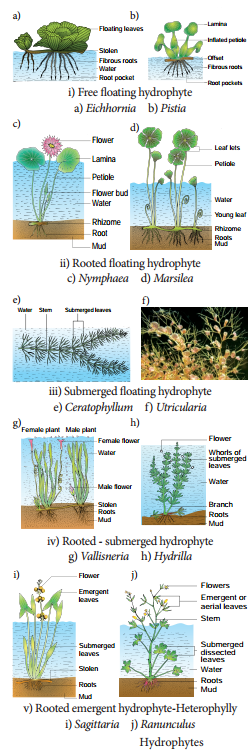
Hygrophytes:
The plants which can grow in moist damp and shady places are called hygrophytes. Examples: Habenaria (Orchid), Mosses (Bryophytes), etc.
Morphological adaptations of Hydrophytes: In root
- Roots are totally absent in Wolff and Salvinia or poorly developed in Hydrilla or well developed in Ranunculus.
- The root caps are replaced by root pockets. Example: Eichhornia
In stem
- The stem is long, slender, spongy and flexible in submerged forms.
- In free flating forms the stem is thick, short stoloniferous and spongy; and in rooted floating forms, it is a rhizome.
- Vegetative propagation is through runners, stolon, stem and root cuttings, tubers, dormant apices and offets.
In leaves
- The leaves are thin, long and ribbon shaped in Vallisneria or long and linear in Potamogeton or finely dissected in Ceratophyllum.
- The floating leaves are large and flat as in Nymphaea and Nelumbo. In Eichhornia and Trapa petioles become swollen and spongy.
- In emergent forms, the leaves show heterophylly (Submerged leaves are dissected and aerial leaves are entire).
Example: Ranunculus, Limnophila heterophylla and Sagittaria
Anatomical adaptations
- Cuticle is either completely absent or if present it is thin and poorly developed
- Single layer of epidermis is present
- Cortex is well developed with aerenchyma
- Vascular tissues are poorly developed. In emergent forms vascular elements are well developed.
- Mechanical tissues are generally absent except in some emergent forms. Pith cells are sclerenchymatous.
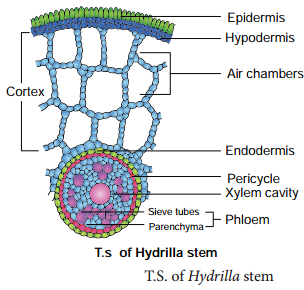
Physiological adaptations of Hydrophytes:
- Hydrophytes have the ability to withstand anaerobic conditions.
- They possess special aerating organs.
Xerophytes
The plants which are living in dry or xeric condition are known as Xerophytes. Xerophytic habitat can be of two different types. They are:
a. Physical dryness:
In these habitats, soil has a little amount of water due to the inability of the soil to hold water because of low rainfall.
b. Physiological dryness:
In these habitats, water is suffiently present but plants are unable to absorb it because of the absence of capillary spaces. Example: Plants in salty and acidic soil. Based on adaptive characters xerophytes are classified into three categories. They are Ephemerals, Succulents and Non succulent plants.
(i) Ephemerals:
These are also called drought escapers or drought evaders. These plants complete their life cycle within a short period (single season). These are not true xerophytes. Examples: Argemone, Mollugo, Tribulus and Tephrosia.
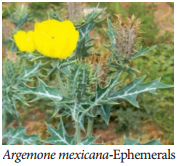
(ii) Succulents:
These are also called drought enduring plants. These plants store water in their plant parts during the dry period. These plants develop certain adaptive characters to resist extreme drought conditions. Examples: Opuntia, Aloe, Bryophyllum and Begonia.
(iii) Non succulents:
These are also called drought resistant plants (true xerophytes). They face both external and internal dryness. They have many adaptations to resist dry conditions. Examples: Casuarina, Nerium, Zizyphus and Acacia.
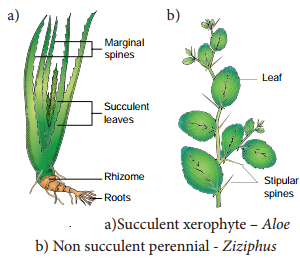
Morphological Adaptations In root
- Root system is well developed and is greater than that of shoot system.
- Root hairs and root caps are also well developed.
In xerophytic plants with the leaves and stem are covered with hairs are called trichophyllous plants. Example: Cucurbits (Melothria and Mukia)
In stem
- Stems are mostly hard and woody. They may be aerial or underground.
- The stems and leaves are covered with wax coating or covered with dense hairs.
- In some xerophytes all the internodes in the stem are modifid into a flashy leaf structure called phylloclades (Opuntia).
- In some of the others single or occasionally two internodes modifid into flashy green structure called cladode (Asparagus).
In some the petiole is modifid into a flashy leaf like structure called phyllode (Acacia melanoxylon).
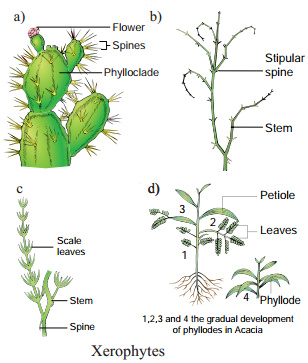
In leaves
- Leaves are generally leathery and shiny to reflect light and heat.
- In some plants like Euphorbia, Acacia, Ziziphus and Capparis, the stipules are modified into spines.
- The entire leaves are modifid into spines (Opuntia) or reduced to scales (Asparagus).
Anatomical adaptations
- Presence of multilayered epidermis with heavy cuticle to prevent water loss due to transpiration.
- Hypodermis is well developed with sclerenchymatous tissues.
- Sunken stomata are present only in the lower epidermis with hairs in the sunken pits.
- Scotoactive type of stomata found in succulent plants.
- Vascular bundles are well developed with several layered bundle sheath.
- Mesophyll is well diffrentiated into palisade and spongy parenchyma.
- In succulents the stem possesses a water storage region.
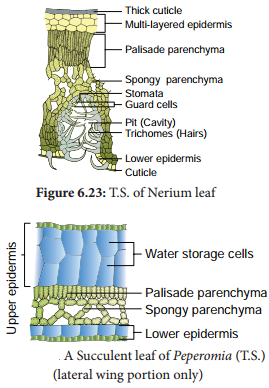
Physiological adaptations
- Most of the physiological processes are designed to reduce transpiration.
- Life cycle is completed within a short period (Ephemerals).
Mesophytes
The plants which are living in moderate conditions (neither too wet nor too dry) are known as mesophytes. These are common land plants. Example: Maize and Hibiscus.
Morphological adaptations
- Root system is well developed with root caps and root hairs.
- Stems are generally aerial, stout and highly branched.
- Leaves are generally large, broad, thin with different shapes.
Anatomical adaptations
- Cuticle in aerial parts are moderately developed.
- Epidermis is well developed and stomata are generally present on both the epidermis.
- Mesophyll is well diffrentiated into palisade and spongy parenchyma.
- Vascular and mechanical tissues are fairly developed and well diffrentiated.
Physiological adaptations
- All physiological processes are normal.
- Temporary wilting takes place at room temperature when there is water scarcity.
Tropophytes are plants which behave as xerophytes at summer and behave as mesophytes (or) hydrophytes during rainy season.
Epiphytes
Epiphytes are plants which grow perched on other plants (Supporting plants). They use the supporting plants only as shelter and not for water or food supply. These epiphytes are commonly seen in tropical rain forests. Examples: Orchids, Lianas, Hanging Mosses and Money plant.
Morphological adaptations
- Root system is extensively developed. These roots may be of two types. They are Clinging roots and Aerial roots. Clinging roots fix the epiphytes firmly on the surface of the supporting objects.
- Aerial roots are green coloured roots which may hang downwardly and absorb moisture from the atmosphere with the help of a spongy tissue called velamen.
- Stem of some epiphytes are succulent and develop pseudobulb or tuber.
- Generally the leaves are lesser in number and may be fleshy and leathery.
- Myrmecophily is a common occurrence in the epiphytic vegetation to prevent the predators.
- The fruits and seeds are very small and usually dispersed by wind, insects and birds.
Anatomical adaptations
- Multilayered epidermis is present. Inner to the velamen tissue, the peculiar exodermis layer is present.
- Presence of thick cuticle and sunken stomata greatly reduces transpiration.
- Succulent epiphytes contain well developed parenchymatous cells to store water.
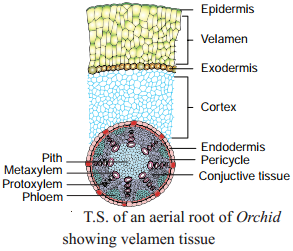
Physiological adaptations
Special absorption processes of water by velamen tissue.
Halophytes
There are special type of Halophytic plants which grow on soils with high concentration of salts. Examples: Rhizophora, Sonneratia and Avicennia.
Halophytes are usually found near the seashores and Estuaries. The soils are physically wet but physiologically dry. As plants cannot use salt water directly they require filtration of salt using physiological processes. This vegetation is also known as mangrove forest and the plants are called mangroves.
Morphological adaptations
- The temperate halophytes are herbaceous but the tropical halophytes are mostly bushy
- In addition to the normal roots, many stilt roots are developed
- A special type of negatively geotropic roots called pneumatophores with pneumathodes to get sufficient aeration are also present. They are called breathing roots. Example: Avicennia
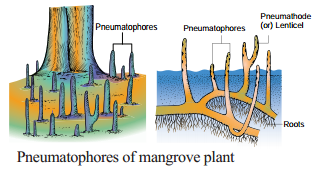
- Presence of thick cuticle on the aerial parts of the plant body
- Leaves are thick, entire, succulent and glossy. Some species are aphyllous (without leaves).

- Viviparous mode of seed germination is found in halophytes
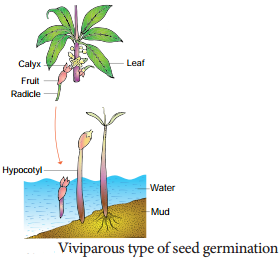
Anatomical adaptations
- Epidermal cells of stem is heavy cutinized, almost squarish and are filled with oil and tannins.
- ‘Star’ shaped sclereids and ‘H’ shaped heavy thickened spicules that provide mechanical strength to cortex are present in the stem.
- The leaves may be dorsiventral or isobilateral with salt secreting glands.
Physiological adaptations
- High osmotic pressure exists in some plants.
- Seeds germinate in the fruits while on the mother plant (Vivipary).